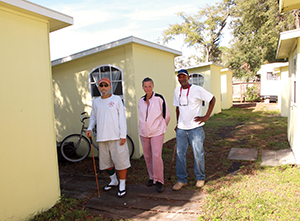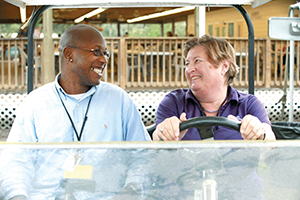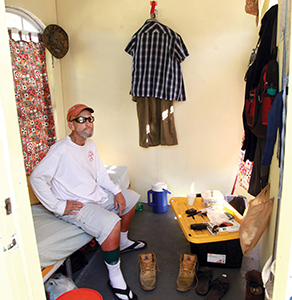By ELLEN F. HARRIS
St. Anthony's provides stability and compassionate care in Tampa Bay area
During his five-week post-op stay in a hospital, Roy McDaniel lost the construction job he'd held for 15 years. With that loss went the house he'd been renting and his beloved dog Bella. Worse, McDaniel needed help to recuperate. Surgeons hadremoved the tumor growing inside his spine, but the growth had so strangled the nerves below his waist that he could no longer walk properly. He could only shuffle.
When he was discharged from a Clearwater, Fla., hospital in March 2014, all McDaniel, 46, had was the hospital gown he was wearing. He was homeless.
Too medically frail to return to the streets, McDaniel was referred to the Medical Respite Program at Pinellas Hope about 20 miles away in St. Petersburg, Fla. There he took up residence in one of 10 casitas, or tiny cottages, on the grounds of Pinellas Hope, a transitional housing and tent city program run by Catholic Charities Diocese of St. Petersburg. Each casita holds a bed, a chair and the person's belongings. A screened window provides ventilation and light. (The structures are not wired for electricity.)
The respite program is a partnership between Catholic Charities and the BayCare Health System of Clearwater; BayCare member St. Anthony's Hospital of St. Petersburg runs it.

Ten casitas on the grounds of Pinellas Hope in St. Petersburg, Fla., provide basic shelter for homeless individuals who require ongoing medical care after hospital treatment. Karl Marshall, left, Renee Moody and Donald Lane, all were patients at St. Anthony's Hospital, before recuperating in the hospital-run Medical Respite Program at Pinellas Hope.
Recovery to stability
"We wanted a place for homeless people like Mr. McDaniel where they could recuperate and receive outpatient care," said Sr. Mary McNally, OSF, vice president of mission integration at St. Anthony's. Collaborative programs between St. Anthony's, BayCare's Morton Plant Mease hospitals and Catholic Charities Diocese of St. Petersburg have been helping McDaniel and others regain their health and rebuild their lives.
St. Anthony's started the casitas program to house homeless patients still in need of medical care after they leave hospitals in the BayCare group in the St. Petersburg-Clearwater area. The Allegany (N.Y.) Franciscan Ministries Foundation provided a start-up grant.
St. Anthony's residential respite program for the homeless is the only one of its kind in the Tampa Bay area. Not every major city has residential medical respite care, but there are medical respite programs in 28 states and the District of Columbia, according to the National Health Care for the Homeless Council.
Respite patients at Pinellas Hope must be ambulatory, as the casitas are 200 feet away from communal restrooms and 500 feet from shower facilities. Registered sex offenders and people with open arrest warrants are not accepted into the program. No illegal drugs or liquor are allowed on the property.
Since the casitas opened in July 2009, more than 200 patients have recovered in them, usually staying from about 40 days to several months. The program costs St. Anthony's about $8,000 per month, which includes a fee to Pinellas Hope, the salary of the coordinator and a home health nurse, and medications, Sr. McNally said.
The home health nurse provides daily care to the respite patients including infusions and wound dressings. The respite coordinator takes patients to their doctors' appointments and dialysis.
"We give these patients the compassionate care they won't get on the streets," Sr. McNally said. "This evolved from our mission of respect and dignity for each person."
Dignity in fresh linens

Once homeless, Roy McDaniel moved from a casita to a tent to an apartment at Pinellas Hope. Here he rides with Laurie Lampert, who directs the Medical Respite Program at Pinellas Hope.
"You can feel their compassion," McDaniel said. "It's not just a job for them. Talking to them is like talking to family," he said. "They checked on me every day. Anything I needed, they provided including fresh linens. I couldn't feel from the waist down and was, for a while, incontinent. The staff made me feel like it was just a mistake and never embarrassed me," he said. "St. Anthony's program made sure my medications and doctors' visits were on time. Miss Laurie was like a guardian angel." That would be Laurie Lampert, the program coordinator for Pinellas Hope.
"I could call Miss Laurie on her day off and she would go get me my prescriptions," McDaniel said.
"What I've found is a lot of homeless people are like Roy McDaniel," Lampert said. "He was working and putting food on the table, living from paycheck to paycheck until he was overwhelmed with medical catastrophe. Then he became homeless."
After three months in the respite program, McDaniel was ready to live in "tent city," another residential program operated on the Pinellas Hope campus. Up to 340 homeless people can sleep in individual tents there. While the respite program is open only to medical patients who are discharged from St. Anthony's or a Morton Plant Mease facility, anyone can apply to the tent program.
After five months in the tent city, McDaniel was ready to advance. He'd begun work sorting mail in the Pinellas Hope office. Unable to stand or sit for long because of the nerve damage, he cannot return to construction. His job enabled him to move up the tier of transitional housing into an apartment building at Pinellas Hope. The 80 units are home to singles and couples with jobs. He and his neighbors pay one-third of their income for rent, electricity and water. The rest they spend on food. The diocese is building another 70-to-80-unit complex.

Karl Marshall rests in his casita. Each small structure holds a bed, a chair and the occupant's belongings.
"We are here for the whole person not just the patient's medical problem," Sr. McNally said.
Round two
Lampert added, "We try to teach our clients to care for themselves. We educate them to make sure they take their medications. We help them establish an everyday life. We help them get back on their feet financially and with responsibilities.
"We find them a job and give them the incentive to work. We want them to get back to a full life," Lampert said.
McDaniel is enrolled in GED classes on site. He sees a counselor every week. "We talk about mental and physical wellness. They ask what your plans are and your goals," he said. Staffers help him and others fill out Social Security applications, and Medicaid and Medicare forms. They take them to job training programs.
"The patients come here for more than shelter," McDaniel said. "They come to get their lives back. Everything at this place is keyed to give you the tools and skills to get up and try again. The way I look at it is my life has changed. This is round two," he said.
Copyright © 2015 by the Catholic Health Association
of the United States
For reprint permission, contact Betty Crosby or call (314) 253-3477.